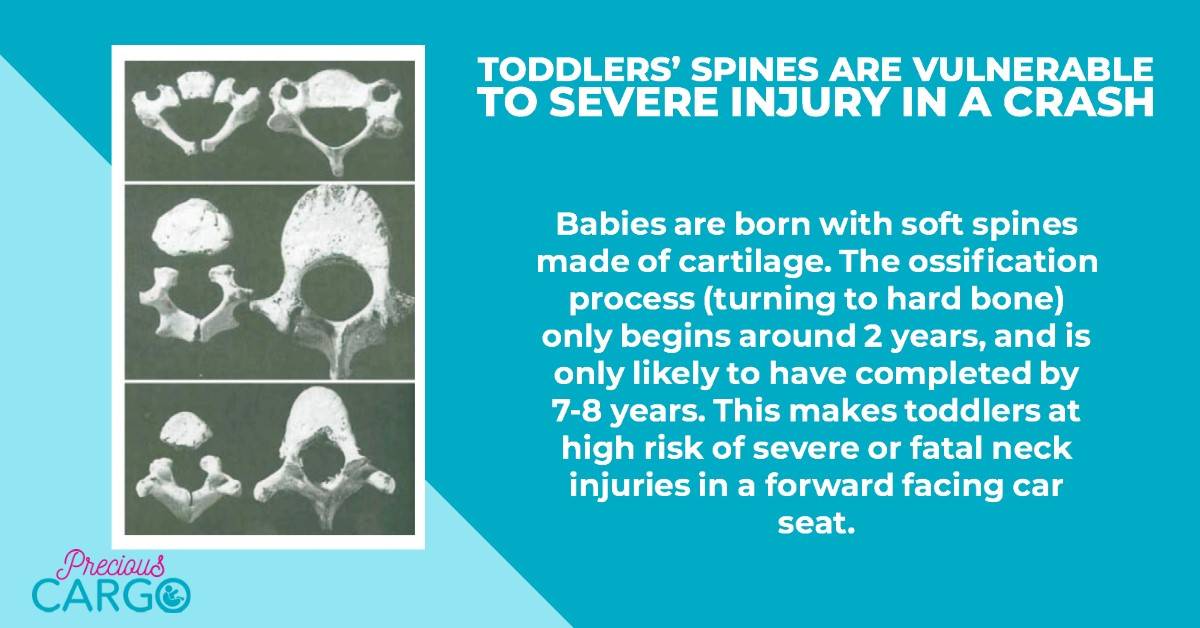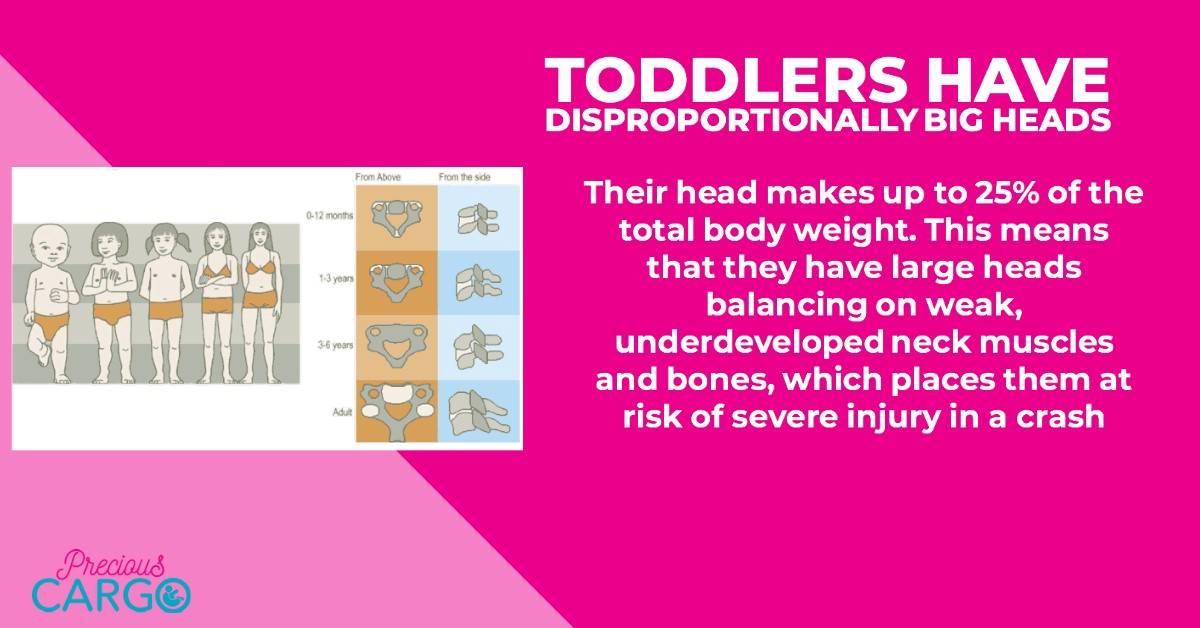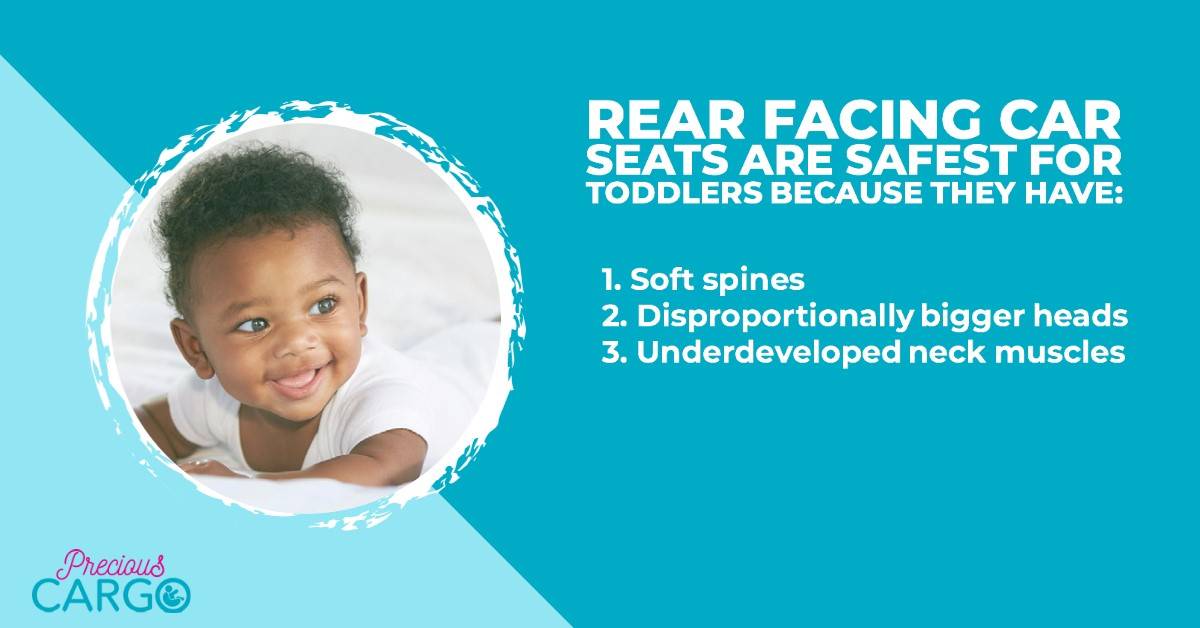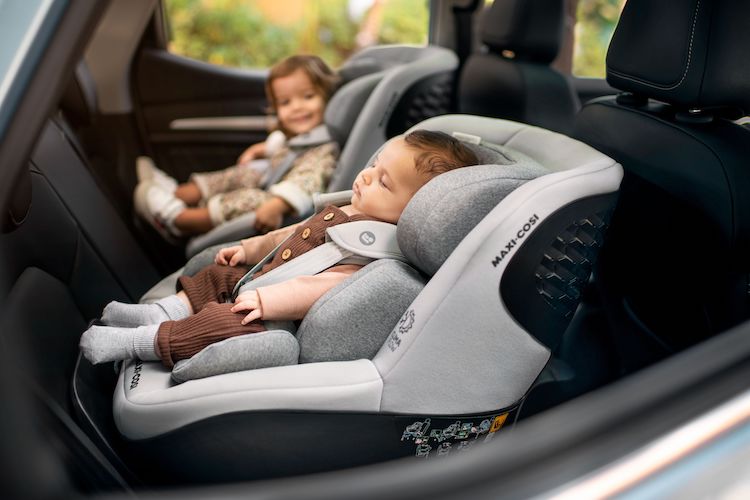

WRITTEN BY JULIE MONSON
Occupational Therapist &
Certified Car Seat Technician
In this article we will discuss the biomechanics of a child's body which places them at greater risk of injury as well as the physics of crash forces involved in an accident.
There have been several medical studies that have conclusively proven that rear facing is FIVE TIMES SAFER than forward facing car seats. This is due to the biomechanics of a child's body; they have soft spines, disproportionally large heads resting on underdeveloped necks. Statistically speaking, roughly 60% of vehicle crashes are frontal impacts and 20% are side impacts (NHTSA). In a forward facing car seat, the child car seat’s 5-point harness restrains the child's torso, placing the majority of the forces on the child’s neck as the head is thrown forward with tremendous force. If the child is seated in a rear facing child car seat, the seat shell cradles the neck and spine and absorbs the impact energy, significantly less strain is put on the child’s neck.
In USA, it has recently become law in most states for children to remain in approved rear facing car seats until AT LEAST 2 years. In According to the Swedish recommendations, a child should sit rear facing in a car seat up to at least four years of age, if not longer. Scandinavian countries have been practicing extended rear facing for 30 years already. It is no surprise that they have the lowest child mortality rates on the road in the world.
1) WHY ARE TODDLERS AT RISK OF INJURY IN CRASHES?
A) TODDLERS HAVE SOFT SPINES
A baby's skeleton initially consists largely of cartilage which is relatively soft; like your ear cartilage. It is gradually ossifies ( cartilage gradually transforms into hard bone), as a child develops.

In the image above, the vertebrae on the left are images of unossified vertebrae of a 1 year old. On the right shows ossified (solid) vertebrae of a 6 year old. This image to the right shows the cervical (top), thoracic (middle), and lumbar (bottom) vertebrae of a one year old. The images on the left show a 1 year old's spine vs the images on the right showing a 6 year old's spine. The synchondroses (connections) are easily visible in each. (McCall, Fassett & Brockmeyer 2004).
These findings above show that before 1 years of age, none of the cartilaginous spaces have completed ossification. In fact, the cartilage in children’s necks only starts to ossify (turn to bone) once they are over 2 years old and is only likely to have completed ossifying by age 7-8 years. The skeleton develops with age, not size.
The fact that young children have looser ligaments, underdeveloped joints and vertebrae that are not yet ossified means that their spines are quite elastic and can stretch up to 5cm, whereas the spinal cord can only stretch to 5mm before it can snap. This can results in spinal cord injury and/ or paralysis and even death.
In adults, the spine is made of hard bone which limits its amount of stretch.
B) TODDLERS HAVE DIsproportionally big heads
Babies are born with disproportionally large heads in relation to their body size. Their head makes up to 25% of the total body weight in comparison to an adult where the head only accounts for about 6% of our total bodyweight. As a baby grows older and taller, the proportions of their bodies even out. Their limbs and trunk grow steadily, but the size of their heads do not grow much bigger.
This means that they have large heads balancing on weak, underdeveloped neck muscles and bones.

C) TODDLERS HAVE UNDERDEVELOPED NECK MUSCLES
A newborn cannot control their head because their motor skills aren't developed and their neck muscles are still weak. Learning to hold their head up is a process that can last until your baby is 6 months old. Even once a baby has developed good head control, their necks are still not strong enough to withstand crash forces like adults can.

These 3 anatomical factors mean that babies and toddlers have large heads, resting on a soft spine with weak neck muscles. Their underdeveloped spines, body size proportions, loose ligaments and weaker muscles means that their necks are far more susceptible to severe injury, paralysis, head injury and even death, in a car accident.

2) THE PHYSICS OF A CRASH
During an accident, the child will travel towards the point of impact, putting all the stress on their neck and spine.
At the moment of impact, there are 3 impacts that happen:
- The car hitting into whatever it strikes,
- The body of the child being restrained by the seat belt or harness,
- The internal organs striking the front of the inside of the body.
a) IS REAR FACING SAFEST IN FRONTAL AND SIDE IMPACT COLLISIONS?
Statistically, approximately 60% of car accidents are frontal impacts and 20% are side impacts. Furthermore, frontal and side impact collisions tend to occur at higher speeds than rear impact collisions, often resulting in severe injuries.
During an accident, a child in a forward facing car seat will move toward the point of impact, putting the most stress on the neck, as the head is thrown around violently whilst the upper body remains tightly held by the harness. Frontal crash tests show that the forces acting on the child's neck is up to five times greater when the child sits forward facing compared to rear facing. Excessive stretching or even transection of the spinal cord can result if a child is involved in a head-on crash while in a forward facing car seat
However, when a child is rear facing, the forces of the crash are distributed more equally along a larger surface area of the backrest of the car seat shell, supporting their neck and spine in alignment and limiting damaging movement.
Compare the crash force distribution of a forward facing vs rear facing car seat in the below video:
b) IS REAR FACING SAFEST IN REAR END COLLISIONS
Parents often raise concern over a rear facing car seat in a rear end collision. Rear ended crashes tend to happen at lower speeds and mainly involve damage to the vehicle. So statistically, its important to have the best protection for frontal crashes.
Another point to consider is that in rear ended and side impact crashes, the driver tends to push the break just before impact, which creates a brake force with a forward direction. In this instance a rear facing child is pushed back into the seat and cradled just the same as in a frontal collision, whilst a forward facing child will be flung forward, losing contact with the back of the seat, making the side impact protection less efficient.
A recent study was conducted of "Rear-Facing Child Restraint Systems in Rear Impact Sled Tests". The study found that rear facing car seats mitigate and manage crash forces in a variety of ways that allow them to provide for protection for rear facing children.
Watch this video regarding rear facing car seats in rear impact collisions:
Although it may be legal in South Africa to have a baby forward facing from 9kg, what is legal is just the bare minimum requirement and is not what is safest when it comes to car seats.
The reality is that babies and children are much safer in an extended rear facing car seat. The best practice recommendation is to rear face to a minimum of 4 years or even longer.
The older a child gets, the more time their spine has to strengthen, and the less vulnerable the spine is likely to be. Without a CT scan, there is no way to know if your child's spinal column has completed the ossification process. Therefore, the safest option is to rear face for as long as possible.
New evidence over the past decade prompted the American Academy of Pediatrics to update the policy statement and technical report Child Passenger Safety. "Children should ride in a rear-facing car safety seat as long as possible, up to the limits of their car safety seat. This will include virtually all children under 2 years of age and most children up to age 4."
There are now several car seats on the South African market that will allow extended rear facing to 18kg/105cm (approximately 4 years) and 7 that allow rear facing to 25kg/112-125cm (approximately 5-7 years).
It is not safe to use a car seat above its maximum approved weight/height limit to rear face. Always follow your car seat manual’s instructions on correct installation and maximum weight and height limits.
extended Rear Facing Car Seats
At Precious Cargo, we only sell the safest car seats that have been independently crash tested and score well for safety. All our toddler seats can rear face to 18kg (approx 4 years) or 25kg (5-7 years) depending on the model. Feel free to contact us should you require assistance choosing the best option for your child.
REFERENCES
https://www.ncbi.nlm.nih.gov/pmc/articles/PMC3256844/
https://publications.aap.org/pediatrics/article/142/5/e20182460/38530/Child-Passenger-Safety
https://www.besafe.com/statistics-safety-in-cars-2018/
https://www.bmj.com/content/338/bmj.b1994.full
https://www.sae.org/publications/technical-papers/content/2018-01-1325/
https://www.ncbi.nlm.nih.gov/pmc/articles/PMC3400202/
https://www.ncbi.nlm.nih.gov/pubmed/19410157
https://www.ncbi.nlm.nih.gov/pubmed/16512656
https://csftl.org/why-rear-facing-the-science-junkies-guide/
http://thecarseatlady.com/5-times-safer/
https://publications.aap.org/aapnews/news/12188
Bull, M. J., & Durbin, D. R. (2008). Rear-Facing Car Safety Seats: Getting The Message Right. Pediatrics, 121 (3), 619-620. DOI: 10.1542/peds.2007-3637
http://www.aappublications.org/news/2018/08/30/passengersafety083018


